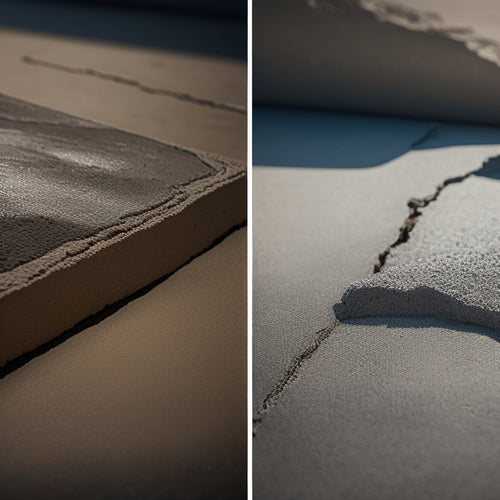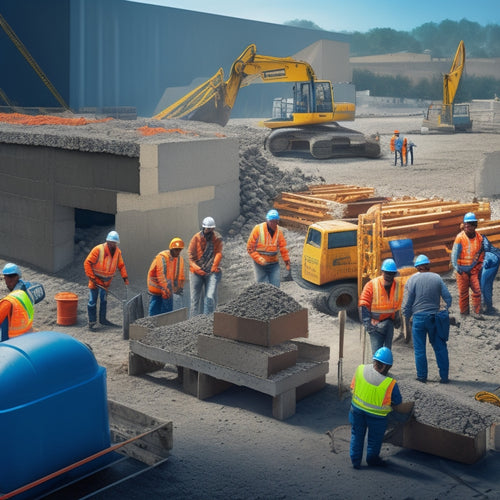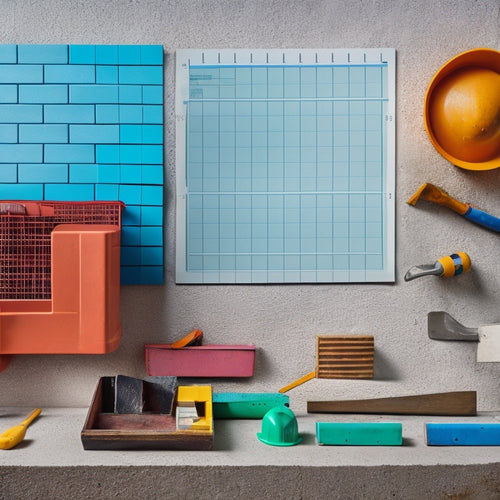
Top Tools for DIY Decorative Concrete Flooring
Share
You'll need a range of tools to achieve a stunning DIY decorative concrete flooring finish. Essential tools include a concrete mixer, trowel, edger, and float for surface preparation. For sanding, you'll require a belt sander, angle grinder, walk-behind sander, handheld sander, orbital sander, and planetary sander, each with the right grit for the job. A buying guide will help you select the perfect sander for your project. With the right tools and techniques, you'll be able to create a high-gloss, showroom-quality finish. Now, get ready to uncover the secrets to achieving a flawless, long-lasting decorative concrete floor.
Key Takeaways
• A concrete mixer is essential for mixing concrete to the right consistency for a smooth finish in DIY decorative concrete flooring.
• Various sanders, including belt, angle grinder, walk-behind, handheld, orbital, planetary, and drum sanders, are necessary for different stages of concrete sanding.
• Choosing the right grit (coarse, medium, or fine) is crucial for achieving the desired finish, and understanding grit aggressiveness helps in selecting the right sequence.
• Safety precautions, such as wearing respirators, safety glasses, earplugs, and gloves, are vital to ensure a safe working environment while using concrete sanding tools.
• Surface preparation, including cleaning, leveling, and applying a bonding agent, is critical for strong adhesion and a successful DIY decorative concrete flooring project.
Essential Concrete Flooring Tools
You'll need a set of essential tools to achieve a professional-looking decorative concrete floor, including a concrete mixer, a trowel, an edger, and a float.
The concrete mixer is vital for mixing the concrete to the right consistency, guaranteeing a smooth finish. A trowel is used to spread and smooth out the concrete mix, while an edger helps to create clean edges and define the pattern. A float is necessary for finishing the surface, removing excess water and air pockets.
Proper surface preparation is also critical to achieve a successful decorative concrete floor. This involves cleaning the subfloor, removing any debris or old adhesives, and making sure it's level and even. You'll need to apply a bonding agent to the subfloor to ensure a strong bond between the old surface and the new concrete.
With these essential tools and a well-prepared surface, you'll be ready to pour and finish your decorative concrete floor. Remember to follow the manufacturer's instructions for mixing the concrete, and take your time to achieve a smooth, even finish.
Concrete Sanders for DIY Projects
As you prepare to tackle your DIY decorative concrete flooring project, you'll need to select the right concrete sanders to achieve the desired finish.
You'll want to take into account the type of sander that suits your project's specific requirements, as well as the grit level needed to produce the desired texture and sheen.
Types of Sanders Needed
Concrete sander selection is critical to achieving a high-quality finish, and for DIY projects, having the right types of sanders is essential to effectively removing imperfections and preparing the surface for further treatment. You'll need a combination of sanders to tackle different stages of the process.
| Sander Type | Grit Range | Usage |
|---|---|---|
| Angle Grinder | 16-36 | Coarse grinding, removing old coatings |
| Walk-Behind Sander | 36-80 | Smoothening, removing minor imperfections |
| Handheld Sander | 80-120 | Fine sanding, polishing |
| Orbital Sander | 120-220 | Final polishing, removing scratches |
When choosing a sander, consider factors like power, speed, and durability. Maintenance is also key; regular cleaning and replacing worn-out pads will guarantee peak performance. Research sander brands and compare their features to find the best fit for your project. Additionally, follow sander maintenance tips to extend their lifespan. By selecting the right sanders and using them correctly, you'll be able to achieve a professional-looking finish that showcases your DIY decorative concrete flooring skills.
Sanders for Various Finishes
To achieve distinct finishes, from matte to high-gloss, you're going to need a range of sanders that cater to specific surface requirements. Depending on the desired finish, you'll need to select a sander that's designed for that particular finish technique.
For instance, a belt sander is ideal for removing old coatings or rough surfaces, while an orbital sander is better suited for finer, more delicate work.
When it comes to achieving a high-gloss finish, you'll need a specialized sander, such as a planetary sander or a high-speed sander. These sander types are designed to remove microscopic scratches and imperfections, leaving a smooth, reflective surface.
On the other hand, if you're aiming for a matte or textured finish, a drum sander or an edger sander may be a better choice. These sanders are designed to remove material quickly and efficiently, while also creating a textured or matte finish.
Choosing the Right Grit
You'll need to pair your chosen sander with the right grit sequence to achieve the desired finish, whether it's a high-gloss shine or a textured, matte look. Grit selection is essential, as it determines the level of aggression and refinement in your sanding process. A proper grit comparison will help you choose the right sequence for your project.
When selecting grits, consider the following factors:
-
Coarse grits (16-30): Ideal for removing old coatings, grinding down rough surfaces, and exposing aggregate.
-
Medium grits (40-80): Suitable for honing and refining surfaces, removing minor imperfections, and creating a smooth finish.
-
Fine grits (100-220): Best for final polishing, achieving high-gloss finishes, and removing minor scratches.
Buying Guide for Concrete Sanders
When buying a concrete sander for your DIY project, you'll need to take into account several key factors to guarantee you get the right tool for the job.
First, you'll need to determine what types of sanders are required for your specific project, whether it's a walk-behind, ride-on, or handheld model.
You'll also need to choose the right grit and take into account essential safety precautions to take when operating these powerful machines.
Types of Sanders Needed
For achieving a smooth, even finish on your decorative concrete flooring, several types of sanders are essential, each serving a specific purpose in the polishing process.
You'll need the right tools to remove imperfections, level the surface, and attain a high-gloss finish.
Here are the types of sanders you'll need:
-
Walk-behind sanders: Ideal for large areas, these heavy-duty sanders are perfect for removing old coatings, leveling the floor, and preparing the surface for polishing.
-
Edge sanders: Designed for tight spaces, edge sanders are used to sand edges, corners, and crevices where walk-behind sanders can't reach.
-
Hand sanders: For finer details and finishing work, hand sanders are perfect for polishing small areas, removing minor imperfections, and applying final finishes.
When selecting sanders, consider sander power ratings, as higher-powered sanders are better suited for heavy-duty tasks.
Additionally, prioritize sander maintenance tips, such as regular cleaning and replacing worn-out pads, to guarantee peak performance and extend the lifespan of your sanders.
With the right combination of sanders, you'll be well on your way to achieving a stunning, professional-looking finish on your decorative concrete flooring.
Choosing the Right Grit
With your arsenal of sanders ready, it's time to focus on the abrasive grits that will make all the difference in achieving a flawless decorative concrete floor.
When it comes to grit selection, you'll need to take into account the specific requirements of your project. Coarser grits (16-24) are ideal for removing old coatings, rough surfaces, or uneven concrete. Medium grits (30-60) are suitable for general-purpose sanding and honing, while finer grits (80-120) are used for polishing and refining the surface.
A key aspect of grit comparison is understanding the aggressiveness and intended use of each grit level. For example, a 16-grit sandpaper is more aggressive than a 24-grit, but both are regarded as coarse.
You'll also want to take into account the bond type, which affects the grit's durability and performance. Open-coat bonds are more aggressive, while closed-coat bonds are better suited for finer grits.
Safety Precautions to Take
You must prioritize personal protective equipment (PPE) and a safe working environment to avoid injuries and health hazards when operating concrete sanders. As you work with these powerful tools, you'll be generating dust, debris, and noise that can harm you and others nearby.
To guarantee a safe and healthy work environment, remember to:
-
Wear respirators or dust masks to prevent inhalation of concrete dust and debris.
-
Use safety glasses or goggles to protect your eyes from flying particles.
-
Wear earplugs or earmuffs to reduce noise exposure and prevent hearing damage.
Implementing safe handling techniques is also essential. Always maintain a firm grip on the sander, keep your work area clean and clear of obstacles, and avoid overreaching or stretching while operating the tool.
Types of Concrete Sanding Pads
Concrete sanding pads come in a variety of grits and bond types, each designed to tackle specific stages of the concrete flooring refinement process. As you refine your sanding techniques, you'll need to switch between different pads to achieve ideal results.
Coarse-grit pads (16-24 grit) are ideal for removing old coatings, rough surfaces, or uneven concrete. These pads typically feature a durable, open-bond structure that allows for aggressive material removal.
In contrast, finer grit pads (30-100 grit) are designed for polishing and honing, producing a high-gloss finish. These pads often feature a denser, closed-bond structure that reduces scratches and swirl marks.
When selecting pad materials, consider the trade-off between durability and flexibility. Metal-bond pads are extremely aggressive but may be prone to clogging, while resin-bond pads offer a balance between durability and flexibility.
You'll also encounter hybrid pads that combine the benefits of different materials. By understanding the strengths and weaknesses of each pad type, you can enhance your sanding process and achieve professional-grade results.
Choosing the Right Sanders
Selecting the right sander for your concrete flooring project is crucial to efficiently utilizing your chosen sanding pads and achieving the desired finish. You'll want to take into account the type of sander that best suits your project's requirements.
There are several sander types to choose from, including:
-
Belt sanders: Ideal for large, open areas and removing old coatings or adhesives.
-
Orbital sanders: Suitable for smaller areas and fine-tuning the surface.
-
Edge sanders: Perfect for sanding along walls, corners, and edges.
When choosing a sander, also think about maintenance. Regularly cleaning and maintaining your sander will extend its lifespan and guarantee peak performance.
Make sure to follow the manufacturer's guidelines for maintenance and troubleshooting.
Best Practices for Sanding Concrete
How thoroughly you prepare the surface will greatly impact the final result, as even the slightest imperfections can be magnified during the sanding process.
To achieve a flawless finish, you must guarantee the concrete is level, clean, and free of cracks or divots. Inspect the surface for any defects and address them before proceeding. Next, apply a concrete bonding agent to promote adhesion between the old and new surfaces.
When sanding, start with a coarse grit (around 16-20) and progressively move to finer grits (up to 120-150) for a high-gloss finish. Employ advanced sanding techniques, such as using a sanding block to maintain even pressure and prevent swirl marks.
Work in small sections, overlapping your passes to guarantee thorough coverage. Keep the sandpaper clean and replace it frequently to prevent clogging. Regularly inspect your work, as uneven sanding can lead to a subpar finish.
Top Concrete Polishing Tools
With a perfectly sanded surface in place, you're ready to take your decorative concrete floor to the next level by employing the right polishing tools to achieve a brilliant, high-gloss finish.
Concrete polishing is an art that requires the right equipment and techniques to achieve the desired results.
To achieve a showroom-quality finish, you'll need the following essential polishing tools:
-
High-speed floor grinders: These machines are designed to remove scratches and imperfections, leaving a smooth surface for polishing.
-
Polishing pads: Available in various grits, these pads are used to progressively refine the surface, removing scratches and achieving a high-gloss finish.
-
Concrete polish: A specialized chemical compound that enhances the appearance of the concrete, providing a deep, rich color and a durable, long-lasting finish.
Mastering polishing techniques and understanding maintenance tips are vital to ensuring the longevity of your decorative concrete floor.
Decorative Concrete Stamping Tools
You'll need a specialized set of decorative concrete stamping tools to create intricate patterns, textures, and designs that mimic natural stone, wood, or other materials, adding an extra layer of visual appeal to your concrete floor. These tools allow you to achieve realistic, high-definition decorative patterns that elevate the aesthetic of your concrete flooring.
Stamps come in various shapes, sizes, and textures, enabling you to experiment with different stamping techniques. You can create anything from rustic, distressed looks to sleek, modern designs. For instance, you can use texture mats to achieve a stone-like appearance or use rigid stampers for more defined patterns.
To master decorative concrete stamping, it's crucial to invest in a quality set of stamping tools. Look for tools made from durable materials that can withstand the rigors of stamping and finishing. Additionally, consider the type of concrete you're working with, as this will influence the choice of stamping tools and techniques.
With practice and patience, you'll be able to access the full potential of decorative concrete stamping and create stunning, one-of-a-kind flooring designs.
Safety Equipment for DIY Projects
As you move on to the next phase of your DIY decorative concrete flooring project, it's imperative to prioritize your safety and invest in the right protective gear to prevent injuries. You can't afford to compromise on safe practices, especially when working with concrete, which can be hazardous if not handled properly.
To guarantee your safety, make sure you have the following essential protective gear:
-
Dust mask or respirator: Prevents inhalation of concrete dust and other harmful particles that can cause respiratory problems.
-
Safety goggles or glasses: Protects your eyes from flying debris, chemical splashes, and other hazards.
-
Steel-toed boots and gloves: Guards your feet and hands from heavy objects, tools, and rough surfaces.
Frequently Asked Questions
Can Decorative Concrete Flooring Be Used in High-Traffic Areas?
You're wondering if decorative concrete flooring can handle high-traffic areas. The answer is yes, but you'll need to address durability concerns.
A well-installed and sealed decorative concrete floor can withstand heavy foot traffic, but it's essential to follow maintenance tips. Regular cleaning, resealing, and avoiding harsh chemicals will guarantee your floor remains durable and visually appealing.
How Long Does a DIY Concrete Flooring Project Typically Take?
When tackling a DIY concrete flooring project, you're likely wondering how long it'll take to complete. The project timeline largely depends on the scope and size of your project.
Typically, you'll need to allow 2-3 weeks for preparation steps, such as cleaning, repairing, and priming the subfloor.
Then, you'll spend 1-2 days applying the concrete, followed by 2-3 days for finishing and sealing.
With careful planning, you can achieve professional-looking results within a few weeks.
Do I Need to Hire a Professional for Complex Designs?
You're steering through uncharted territory, like a ship captain charting a new course, when it comes to determining if you need a pro for complex designs.
Take an honest skill assessment: can you execute intricate patterns, precision cuts, and flawless color integration?
If design complexity overwhelms you, don't risk a subpar finish.
Be realistic about your abilities and consider hiring a professional to guarantee a showroom-worthy result that reflects your vision.
Can I Install Decorative Concrete Flooring Over Existing Flooring?
When considering installing decorative concrete flooring over existing flooring, you'll need to assess the current floor's condition and prepare it properly.
You'll need to evaluate the subfloor's integrity, ensuring it's level, clean, and dry.
Then, choose the right installation methods, such as overlay or underlayment, depending on the existing flooring type.
Proper flooring preparation is essential, so don't skip this step to achieve a successful and durable decorative concrete floor.
Is Decorative Concrete Flooring Resistant to Scratches and Stains?
You're probably wondering if decorative concrete flooring can withstand the wear and tear of daily life.
Let's explore the truth: decorative concrete flooring is indeed resistant to scratches and stains. The secret lies in its dense, non-porous surface, which prevents stains from seeping in.
Additionally, a well-applied sealant enhances scratch resistance, making it a low-maintenance option for high-traffic areas.
With proper care, you can enjoy your decorative concrete flooring for years to come, free from scratches and stains.
Conclusion
As you step back to admire your handiwork, the transformed concrete floor glimmers like polished stone, radiating a warm, earthy glow.
The once-dull surface now shimmers with a mesmerizing sheen, a proof of your perseverance and skill.
With the right tools and techniques, you've revealed the hidden beauty within the concrete, creating a stunning work of art that's as functional as it's breathtaking.
Your DIY decorative concrete flooring masterpiece is now ready to be showcased to the world.
Related Posts
-

What Tools Ensure Strong Concrete Adhesion at Home
You'll need the right tools to guarantee strong concrete adhesion at home. For surface preparation, use concrete surf...
-

7 Best Tools for Concrete Block Construction
You'll need a solid foundation, precise cutting, and seamless finishing to guarantee your concrete block construction...
-

Reinforcement Tools Checklist for Concrete Block Walls
You'll need a range of reinforcement materials, including horizontal and vertical rebar, fiber mesh, and anchor bolts...


